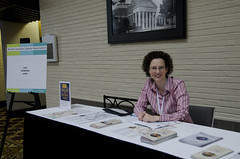This article is more than 5 years old.
Since I live very close to the Convention Center, I volunteered for the Local Arrangements Committee. In addition to managing the bag-stuffing operation, I spent several hours staffing the Local Information Booth, from which I gave opinionated advice about local restaurants (and handed out restaurant guides prepared by Hu!). I was thrilled to leave my car at home for three days straight, but was mildly disappointed to discover that I didn’t win the short distance award. To my knowledge, that honor belongs to another ZSR librarian (ask around offline if you want to know who!) and a librarian from High Point U. who lives downtown.

I still had time to attend some of the sessions. I’ll skip talking about sessions already discussed by other ZSR bloggers, and a few others where my main takeaway was confirming that I am already up on current trends. Here are more details on three sessions where I learned a lot of valuable new-to-me information.
Demystifying Fund Formulas in an Academic Library Setting
Lisa Barricella & Cindy Shirkey, ECU
ECU was looking for a different way to allocate the monograph portion of their budget. Their previous formula – based on factors like credit hours, faculty headcount, grad students, etc. – had several flaws. For instance, using credit hours earned in a subject would overfund areas like foreign languages where there is a lot of enrollment at the lower levels, but not a lot of need for library materials. Also their old formula – just for monographs – didn’t account for the journals v. books breakdown which is unique to each discipline. (There was also the procedural issue that the data, which came from sources external to the library, was sometimes very difficult to collect.) Their new formula relied heavily on two factors: how much the collection in, say, Art was used as a proportion of the entire collection and how many ILLs did Art generate in proportion to their holdings. Both of these criteria more closely map to the actual demand for monographic materials in that subject. (The ILL part was not fully implemented due to specific failures in ILLIAD reporting.) Finally the average price of books was considered. While I’m not looking to redo all the monograph budgets anytime soon, I will keep these ideas in mind in case we ever need to overhaul our monograph budget structure.
Taming the Hydra: A Strategic Approach
Kim Vassiliadis, Emily King & Chad Haefele, UNC
This presentation is about how UNC corralled a whole bunch of subject guide thingies all over their website, deleted about half of them, and got all the rest into LibGuides with an updated (and consistent) look-and-feel. Then they initiated a plan to make sure that each LibGuide gets some maintenance at least once a year. Guides that are not updated are given “unpublished” status (i.e. suppressed from public view) in LibGuides. I’m impressed that they were able to pull this off in the decentralized environment at UNC. One rule they implemented was that you can’t have more than one row of tabs. Also every guide has to have an intro paragraph that lists all the tabs. I actually disagree with the intro paragraph idea. More on that in a minute.
I Honestly Had No Idea: LibGuides Usability Assessment in an Academic Library
Randall Bowman, Teresa LePors & Shannon Tennant, Elon
LibGuides best practices is an area where a lot of folks (including yours truly) have lots of ideas but very little evidence. Elon conducted a usability test with some undergraduates to fill the evidence gap. In addition to asking students to perform tasks, they asked some subjective questions at the end.
Some of their conclusions:
- Students go straight for the search box, any search box. That’s bad news on my guides since the only embedded search box is for “Search this Guide.” That’s also bad if the source with a search box is not the best place to go for that topic. For one task, the relevant guide had a JSTOR search box embedded (also with the pretty “J” logo). However, JSTOR did not contain the particular article that students needed to find.
- Students don’t read the text on the page. They quickly scan for something that looks familiar.
- Students ignore the tabs. (Paraphrased comment from audience: I’ve been to three presentations on LibGuides, and they all say that students don’t use tabs! However, LibGuides is built around tabs!)
- Students were split (on both the tasks and the subjective questions) as to whether “Articles” or “Databases” was the best word for leading students to databases that contain articles. (My own guides hedge on this one by saying e.g. “Linguistics Databases for Finding Journal Articles”)
- Students don’t scroll, which is bad news if you’re also not using tabs
- Elon’s main LibGuides page prominently featured the tag cloud. Students didn’t use it, and on the subjective questions they Xed it out as an unnecessary element.
- Students liked the librarian profiles, which include an embedded chat window. A significant percentage of their chat questions are referred by the research guide pages.
Based on what they learned, Elon is going to lose the tag cloud and have the front page of each LibGuide list all the tabs (like UNC). I disagree with this “intro paragraph” approach since it was also established that students don’t read the text! When I have time, I’m going to edit my LibGuides so that the #1 resource is a search widget, preferably with a pretty logo. If there is no pretty logo, then maybe I’ll add the “Best Bet” star like we use on the database pages.

8 Comments on ‘Carol at NCLA 2013’
Any chance Elon will publish their study? Sounds really interesting!
They’re considering it. NCLA has posted their slides online. They’re hard to read in this format, which is why I didn’t link to them in the main post.
http://www.nclaonline.org/2013-conference/view-presentations-thursday
I wish I’d been there to hear the “opinionated advice about local restaurants!”
Thanks for the report on the LibGuides presentation, Carol. I thought I would point out a couple of options — one existing and one part of the upcoming version 2 of LibGuides — that address some of the issues raised here.
“Search This Guide” is the default for the embedded search box when users visit any LibGuide. But that default can be changed on a site-wide basis to something that might better meet student expectations of a search box: the library catalog, a discovery system, a federated search, a general interest database, Google, or anything else. There is more info on these options at http://help.springshare.com/settinguplg/searchoptions#11099698
LibGuides 2 will offer an alternative to tabbed navigation with a side navigation option. Site administrators will be able to mandate that one or the other is used for all guides on the site or give guide authors the option to select one or the other for each of their guides.
– Ken Liss
Springshare Community Support & Training
Thanks Ken, for this info.
Thanks for this – it’s so hard to know what’s best in LibGuide design especially if students don’t read and won’t scroll 🙂 Ours get used a lot, so I’m wondering if there is any way to see how many of our DB or catalog referrals are coming from LibGuides to see which links are actually getting clicked on. Hmmmmmmm. Food for thought!!
Roz – You can see how many times links are clicked on in LibGuides by going to Statistics and clicking on the Links tab and then on All Links. This will only show you data for links that are in Simple Web Links and Links & Lists boxes (not links in Rich Text boxes). The default view shows daily hits for the past week, but that can be changed to monthly hits for whatever time period you want to see. – Ken
The search box thing is interesting — we usability tested our LibGuides at Coastal, too, and about half my testers plugged keywords into the Search This Guide box rather than the Ebsco Discovery search widget we had on the page. We finally just suppressed that box in our guides with CSS (though as a librarian, I missed having it there).